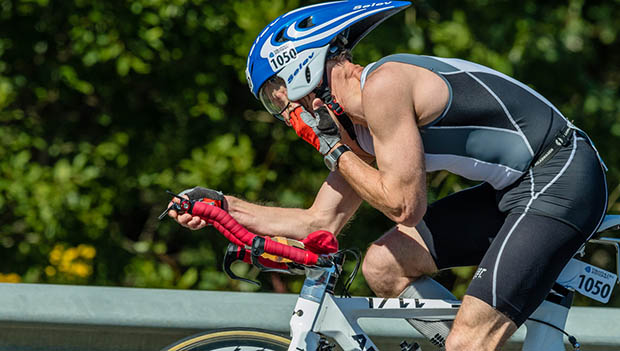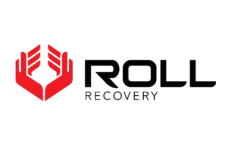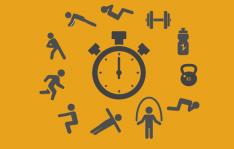
What do you do on race day if everything doesn't go as planned? Maybe your goggles leak, you get a flat on the bike or you feel like you're overheating on the run. How you manage your day and what the outcome will be depends on the distance of your event, how you're feeling and maybe even a little luck.
Forgotten Gear or Accessories
Make a list and check it twice. You'll want to pack all of your gear the night before your race or even the night before that if you have to check your bike into transition the day before the race. But if you find that despite your best planning that you've forgotten something—whether it's nutrition, a hydration bottle or a cycling helmet or tri shoes—ask around. And ask the race director to make an announcement over the PA system on your behalf to see if anyone can lend you what you forgot.Swim Troubles
The swim can be intimidating, with all that kicking and thrashing. Don't panic—this will only add fatigue and distract you from your goal of finishing. If you feel as though you're really uncomfortable, move out of the fray and let traffic pass. Take a couple of strokes on your back or with your face out of the water. Tread water, pause for a moment and regain your composure. If you need to hang onto a rescue kayak and regain your composure, remember that you'll still be allowed to finish, as long as you keep your forward progress and don't get a tow back to shore.
If you find that your swim goggles are leaking and you're doing a short swim, keep going. You can make a sprint distance swim without perfect vision. But if you're in for a longer swim and your vision is compromised by leaky lenses, move out of traffic, roll onto your back and clear and reset your goggles. The few moments it takes to do this can be made up on the bike.
Flat Tire
The bike is where many variables can come into play. If you get a flat, it's OK to take a few minutes to change your tube. Since you've already practiced this skill, you'll be efficient at removing your wheel, then the tire, replacing the tube, reseating the tire, inflating the tube and resetting the wheel in under five minutes. You did practice these steps, right?
Our mantra: Slow is fast. Perform the steps to replace your tube patiently; don't try to hurry this process, as you'll be more likely to introduce errors and risk having to repeat the entire process. Once you get rolling again, be smart. If you try to make up for a lot of lost time and hit the bike too hard, you'll suffer on the run. After you get rolling again, execute your race as planned.
Other Mechanical Issues
If you suffer another mechanical issue—like poor shifting performance, a broken chain or some other failure—you might have to wait for the race mechanic, which might only be available in larger events. Remember: It's against the rules—and you risk disqualification—if you accept any outside assistance. As tempting as it may be to let a kind stranger help you, decline any offer for help. If you suffer a serious mechanical—your cockpit or seatpost comes loose or your spokes break, for instance—you might have to prematurely end your race. Attempting to race on a compromised bike, even if it's rideable, is risky and not advised.
Where Did Everybody Go?
If you go off course—that is, there's nothing around on the road that looks remotely like the race—stop. Backtrack, until you see other competitors. This can happen at the front of the race, the back of the race or even in the middle of a race if there are large gaps between start waves.
Hard Landing
If you crash and hit the ground while riding, get off the road as efficiently as possible and pause for a moment before trying to get going again. Even if you feel fine, take a moment to assess your body and see if your bike is OK. You don't want to race on a broken bike and risk further injury. If you think you'll be OK and just suffered some scrapes, start back up. But if you're unsure, don't continue. Get help; get to the event medical support and get checked out. It's always better to be safe than sorry. There are so many more races to enter, so you can try again after you recover.
Running Around
You've made it to the run! But what happens if G-I issues force you to a mobile toilet? Heed nature's call. For a shorter event, you just might be able to manage without the pit stop, but for a longer event, trust us when we say to take that quick potty break. You'll be thankful later.
Thermal Failure
If you find that you're overheating on the run, slow down. At the next aid station, don't be afraid to shower yourself with several cups of water (and make sure it's water, not sports drink). If you want to finish, you'll need to get your core temp down. Soak your head; if you have a hat on, soak that, as well as your racing kit. Then walk for a few minutes. Trying to get back to race-pace right after you cooled off will only cause you to overheat again.
Sugar Crash
If you find you're starting to bonk on the run, get to the next aid station and assess how you're feeling. This may mean slowing your pace. Take in any carbohydrates and electrolyte drinks being offered. If there is nutrition, take in some calories. It's difficult to come back from a sugar-crash, but if you want to finish, you can, you'll just need to moderate your pace.
When to Abandon
Some days, finishing just might not be an option if something goes more than a little wrong for you while you're racing. If you feel anything other than the typical discomfort from race effort—you should never feel any numbness while cycling and never favor one leg while running—make a judgement call to retire. Don't risk long-term injury. If you have to pull off your race number, the earlier in the race you do so, the more likely you can be recovered enough to compete at another event in the near future.
READ THIS NEXT: 15 Triathlon Triumphs That Don't Require Winning








Discuss This Article